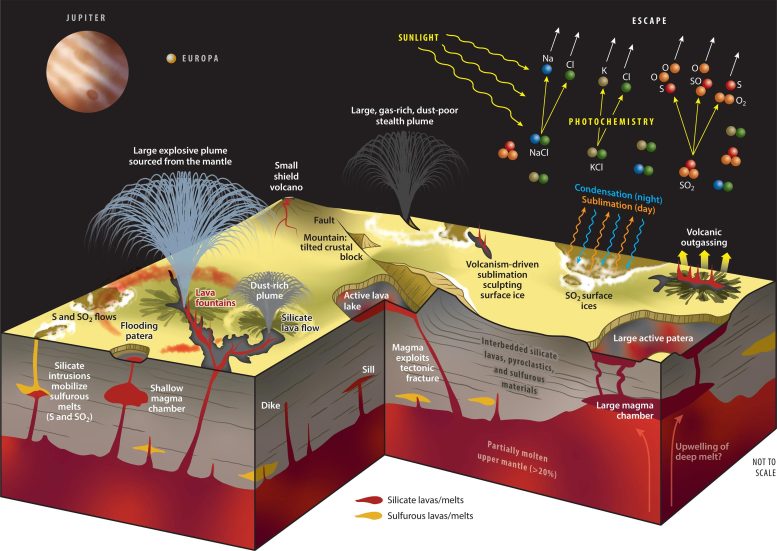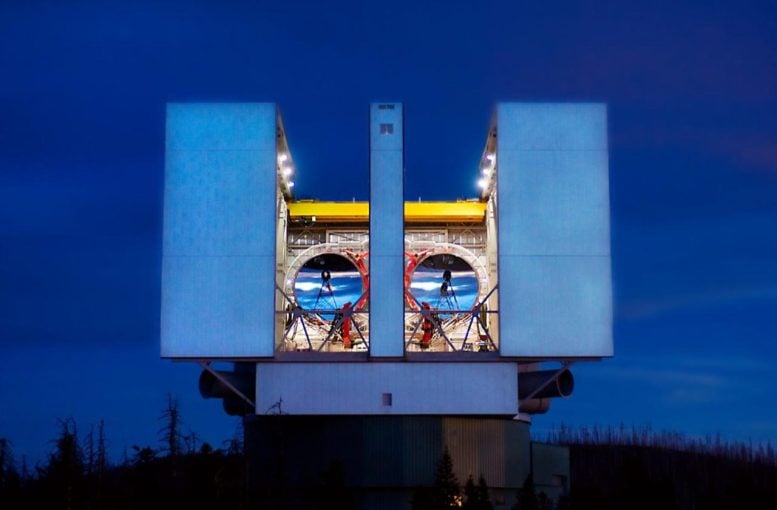Jupiter moon Io, imaged by SHARK-VIS on January 10, 2024. This is the highest resolution image of Io ever obtained by an Earth-based telescope. The image combines three spectral bands — infrared, red and yellow — to highlight the reddish ring around the volcano Pele (below and to the right of the moon’s center) and the white ring around Pillan Patera, to the right of Pele. Credit: INAF/Large Binocular Telescope Observatory/Georgia State University; IRV-band observations by SHARK-VIS/F. Pedichini; processing by D. Hope, S. Jefferies, G. Li Causi
Advanced imaging technology has captured unprecedentedly clear images of 
A cross-section through Io’s crust depicting scientists’ current understanding of the geological and chemical processes that sculpt the surface and produce the moon’s atmosphere. On the left is a plume and red ring of sulfur similar to that generated by the Pele lava lake. Faults in the mostly cold lithosphere act as pathways for silicate magma rich in sulfur to reach the surface. Io’s interior is heated by friction caused by gravitational tugs from Jupiter and two of its moons, Europa and Ganymede, which generate molten magma. Credit: de Pater et al., 2021, Annual Reviews, based on a figure by Doug Beckner, James Tuttle Keane, Ashley Davies
The images reveal surface features as small as 50 miles across, a spatial resolution that until now had been achievable only with spacecraft sent to Jupiter, such as the two Voyager spacecraft in 1979, the Galileo mission, which ended in 2003, and Juno, which has been orbiting Jupiter since 2016. The resolution is equivalent to taking a picture of a dime-sized object from 100 miles away, according to the research team. The images are two to three times better than could be obtained through the analyzed infrared images from NASA’s newest observatory, the 
The Large Binocular Telescope in Arizona. The LBTI instrument combines infrared light from both 8.4m mirrors to image planets and disks around young and nearby stars. Credit: D. Steele, Large Binocular Telescope Observatory
Her hope is to combine optical images from the LBT with infrared observations to correlate glowing hot magma with visible features, such as lava flows and colorful deposits created by fallout from volcanic plumes.
“I hope we can do simultaneous observations at some point in the infrared and visible to see the hot magma and then the effect of that on the surface,” she said. “Sharper images at visible wavelengths like those provided by SHARK-VIS and LBT are essential to identify both locations of eruptions and surface changes not detectable in the infrared, such as new plume deposits.”
Pele and Pillan Patera, Dueling Volcanoes
According to the paper’s first author, Al Conrad, an associate staff scientist at the Large Binocular Telescope Observatory, the eruptions on Io — the most volcanically active body in the solar system — dwarf their contemporaries on Earth. Studies like this one will help researchers understand why some worlds in the solar system are volcanic, but not others, he said, and may someday shed light on volcanic worlds in 
A raw image of Io captured by the Juno spacecraft as it flew by the moon on April 9, 2024, rotated so that Io north is up. The reddish ring around Pele at the lower right edge seems to be complete after having been partly obscured by white frozen sulfur dioxide from Pillan Patera in January 2024. At the time this image was taken, Juno was about 10,250 miles (16,500 kilometers) above the surface of Io. Credit: NASA/JPL-Caltech/SwRI/MSSS
Slightly larger than Earth’s moon, Io is the innermost of Jupiter’s Galilean moons, which in addition to Io include Europa, Ganymede, and Callisto. Locked in a gravitational “tug of war” among Jupiter, Europa, and Ganymede, Io is constantly being squeezed, leading to frictional heat buildup in its interior — believed to be the cause for its sustained and widespread volcanic activity.
By monitoring the eruptions on Io’s surface, scientists hope to gain insights into the heat-driven movement of material underneath the moon’s surface, its internal structure, and, ultimately, on the tidal heating mechanism responsible for Io’s intense volcanism.
Detailed Observations of Volcanic Interactions
Davies said that the new image taken by SHARK-VIS is so rich in detail that it has allowed the team to identify a major resurfacing event in which the plume deposit around a prominent volcano known as Pele, located in Io’s southern hemisphere close to the equator, is being covered by eruption deposits from Pillan Patera, a neighboring volcano. A similar eruption sequence was observed by NASA’s Galileo spacecraft, which explored the Jupiter system between 1995 and 2003.
“We interpret the changes as dark lava deposits and white sulfur dioxide deposits originating from an eruption at Pillan Patera that partially cover Pele’s red, sulfur-rich plume deposit,” Davies said. “Before SHARK-VIS, such resurfacing events were impossible to observe from Earth.”
According to de Pater, Pele seems to erupt continuously, sending plumes of volcanic gases some 300 kilometers above Io’s surface — high enough to have been imaged by Voyager, Galileo, and Hubble. The gases in the plume, which emerge from a lava lake, freeze and settle on the surface as a prominent, broad, reddish, sulfur-rich ring.
Pillan Patera, on the other hand, seems to erupt episodically, leaving emplaced lava surrounded by a white ring of frozen sulfur dioxide (SO2). The new images show the white deposits obscuring Pele’s reddish deposits, though likely for only a brief period. Photos of Io taken by Juno in April showed a nearly complete orange ring, with perhaps a hint of paler red where Pillan’s deposits had been.
“It’s kind of a competition between the Pillan eruption and the Pele eruption, how much and how fast each deposits,” she said. “As soon as Pillan completely stops, then it will be covered up again by Pele’s red deposits.”
Future Prospects With SHARK-VIS
SHARK-VIS was built by the Italian National Institute for Astrophysics at the Rome Astronomical Observatory and is managed by a team led by principal investigator Fernando Pedichini, assisted by project manager Roberto Piazzesi. In 2023, it was installed at the LBT, together with its complementary near-infrared instrument SHARK-NIR, to fully take advantage of the telescope’s outstanding adaptive optics system. The instrument houses a fast, ultra-low noise camera that allows it to observe the sky in “fast imaging” mode, capturing slow-motion footage that freezes the optical distortions caused by atmospheric turbulence, and to post-process data to an unprecedented sharpness.
SHARK-VIS instrument scientist Simone Antoniucci said he anticipates new observations to be made on objects throughout the solar system.
“The keen vision of SHARK-VIS is particularly suited to observing the surfaces of many solar system bodies — not only the moons of giant planets, but also asteroids,” he said. “We have already observed some of those, with the data currently being analyzed, and are planning to observe more.”
For more on this study, see Io’s Volcanic Surfaces Revealed by New Telescope Technology.
The LBT is part of Mount Graham International Observatory, a division of the University of Arizona’s Steward Observatory.














/https://tf-cmsv2-smithsonianmag-media.s3.amazonaws.com/filer_public/34/31/3431771d-41e2-4f97-aed2-c5f1df5295da/gettyimages-1441066266_web.jpg)







Discussion about this post